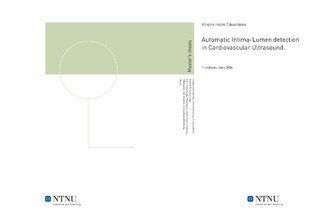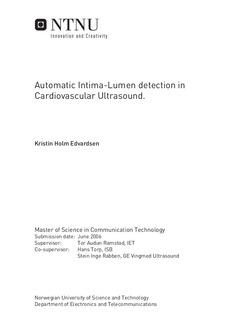| dc.contributor.advisor | Ramstad, Tor Audun | nb_NO |
| dc.contributor.advisor | Torp, Hans | |
| dc.contributor.advisor | Rabben, Stein Inge | |
| dc.contributor.author | Edvardsen, Kristin Holm | nb_NO |
| dc.date.accessioned | 2014-12-19T13:43:56Z | |
| dc.date.accessioned | 2015-12-22T11:41:41Z | |
| dc.date.available | 2014-12-19T13:43:56Z | |
| dc.date.available | 2015-12-22T11:41:41Z | |
| dc.date.created | 2010-09-04 | nb_NO |
| dc.date.issued | 2006 | nb_NO |
| dc.identifier | 348385 | nb_NO |
| dc.identifier | ntnudaim:1304 | |
| dc.identifier.uri | http://hdl.handle.net/11250/2369295 | |
| dc.description.abstract | The main goal in this thesis has been to develop an algorithm that robustly identifies the Carotid artery wall boundaries throughout a heart cycle in an ultrasound image. An existing automatic vessel detection algorithm (AVDA) uses tissue velocity imaging(TVI) and B-mode data to score candidate points from various criteria. The candidate pair with the lowest score gets selected. AVDA was extended by implementing two alternative criteria to the existing external cost criterion. The first by combining the information on gradient and standard deviation in the intensity signatures; the GradTrans criterion (GTC).The second by exploiting the shape of the intensity signature across the vessel wall in the detection of the intima-lumen interfaces and using a Model Matching criterion with 1.5 Gaussian curves (MMC1.5). An edge criteria modeling tool (ECMT) was developed for the purpose of studying the intensity signatures across the vessel wall to find out how the various cost criteria score the signatures of different datasets. In addition, the ECMT was used for parameter tuning. The implemented criteria were verified by comparing automatically detected edges with manual detected edges on 22 datasets. In addition automatically detected vessel diameter was compared against manually detected diameter on 49 datasets. The verification indicated that the GTC is not a good criterion for detecting the intima-lumen interface. The GTC either completely failed to detect the wall or detected the media-adventitia boundary instead of the intima-lumen boundary. The MMC1.5 criterion, on the other hand, seems promising. The criterion seems to often detect the wall correctly or with a small deviation. Compared with manual diameter measurement, MMC1.5 had a bias of 0.014 mm and std of the error was 1.056. In some images the criterion failed completely in correct detection of the wall. The reason being that a similar structure in the wall or an artifact in the lumen was detected instead. After removing these outlays, the diameter detection by MMC1.5 had a bias of 0.146 mm and std of 0.347 mm. The criterion has to be developed further to be more robust and less time consuming, and to overcome the problems of complete failure. A feasability study was done to see whether the AVDA can be used on Brachialis recordings to increase the efficiency of the Flow Mediated Dilation measures. The study seems promising when using the Gradient criterion. This makes it possible to automatically measure diameter changes throughout a heart cycle as well as measuring the differences in diameter between recordings. | nb_NO |
| dc.language | eng | nb_NO |
| dc.publisher | Institutt for elektronikk og telekommunikasjon | nb_NO |
| dc.subject | ntnudaim | no_NO |
| dc.subject | SIE7 kommunikasjonsteknologi | |
| dc.subject | Signalbehandling og kommunikasjon | |
| dc.title | Automatic Intima-Lumen detection in Cardiovascular Ultrasound. | nb_NO |
| dc.type | Master thesis | nb_NO |
| dc.source.pagenumber | 84 | nb_NO |
| dc.contributor.department | Norges teknisk-naturvitenskapelige universitet, Fakultet for informasjonsteknologi, matematikk og elektroteknikk, Institutt for elektronikk og telekommunikasjon | nb_NO |

